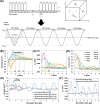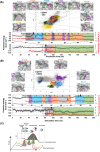Exploring ligand binding pathways on proteins using hypersound-accelerated molecular dynamics
- PMID: 33990583
- PMCID: PMC8121818
- DOI: 10.1038/s41467-021-23157-1
Exploring ligand binding pathways on proteins using hypersound-accelerated molecular dynamics
Abstract
Capturing the dynamic processes of biomolecular systems in atomistic detail remains difficult despite recent experimental advances. Although molecular dynamics (MD) techniques enable atomic-level observations, simulations of "slow" biomolecular processes (with timescales longer than submilliseconds) are challenging because of current computer speed limitations. Therefore, we developed a method to accelerate MD simulations by high-frequency ultrasound perturbation. The binding events between the protein CDK2 and its small-molecule inhibitors were nearly undetectable in 100-ns conventional MD, but the method successfully accelerated their slow binding rates by up to 10-20 times. Hypersound-accelerated MD simulations revealed a variety of microscopic kinetic features of the inhibitors on the protein surface, such as the existence of different binding pathways to the active site. Moreover, the simulations allowed the estimation of the corresponding kinetic parameters and exploring other druggable pockets. This method can thus provide deeper insight into the microscopic interactions controlling biomolecular processes.
Conflict of interest statement
The authors declare no competing interests.
Figures



Similar articles
-
Accelerating Rare Dissociative Processes in Biomolecules Using Selectively Scaled MD Simulations.J Chem Theory Comput. 2019 Nov 12;15(11):5817-5828. doi: 10.1021/acs.jctc.9b00262. Epub 2019 Oct 4. J Chem Theory Comput. 2019. PMID: 31509413
-
Molecular simulation studies on the binding selectivity of 2-anilino-4-(thiazol-5-yl)-pyrimidines in complexes with CDK2 and CDK7.Mol Biosyst. 2016 Jan;12(1):145-61. doi: 10.1039/c5mb00630a. Mol Biosyst. 2016. PMID: 26565382
-
The Effect of Conformational Flexibility on Binding Free Energy Estimation between Kinases and Their Inhibitors.J Chem Inf Model. 2016 Dec 27;56(12):2445-2456. doi: 10.1021/acs.jcim.6b00398. Epub 2016 Dec 6. J Chem Inf Model. 2016. PMID: 28024406
-
Binding free energy estimation for protein-ligand complex based on MM-PBSA with various partial charge models.Curr Pharm Des. 2013;19(12):2293-307. doi: 10.2174/1381612811319120016. Curr Pharm Des. 2013. PMID: 23082979 Review.
-
Molecular dynamics simulations: Insights into protein and protein ligand interactions.Adv Pharmacol. 2025;103:139-162. doi: 10.1016/bs.apha.2025.01.007. Epub 2025 Feb 6. Adv Pharmacol. 2025. PMID: 40175039 Review.
Cited by
-
Pepsin-like aspartic proteases (PAPs) as model systems for combining biomolecular simulation with biophysical experiments.RSC Adv. 2021 Mar 17;11(18):11026-11047. doi: 10.1039/d0ra10359d. eCollection 2021 Mar 10. RSC Adv. 2021. PMID: 35423571 Free PMC article. Review.
-
Probing the Suitability of Different Ca2+ Parameters for Long Simulations of Diisopropyl Fluorophosphatase.Molecules. 2021 Sep 26;26(19):5839. doi: 10.3390/molecules26195839. Molecules. 2021. PMID: 34641383 Free PMC article.
-
Ligand-induced shifts in conformational ensembles that describe transcriptional activation.Elife. 2022 Oct 12;11:e80140. doi: 10.7554/eLife.80140. Elife. 2022. PMID: 36222302 Free PMC article.
-
Systems engineering of Escherichia coli for high-level glutarate production from glucose.Nat Commun. 2024 Feb 3;15(1):1032. doi: 10.1038/s41467-024-45448-z. Nat Commun. 2024. Retraction in: Nat Commun. 2024 Oct 9;15(1):8742. doi: 10.1038/s41467-024-53070-2. PMID: 38310110 Free PMC article. Retracted.
-
Recent Developments in Positron Emission Tomography Tracers for Proteinopathies Imaging in Dementia.Front Aging Neurosci. 2022 Jan 3;13:751897. doi: 10.3389/fnagi.2021.751897. eCollection 2021. Front Aging Neurosci. 2022. PMID: 35046791 Free PMC article. Review.
References
Publication types
MeSH terms
Substances
LinkOut - more resources
Full Text Sources
Other Literature Sources
Miscellaneous

